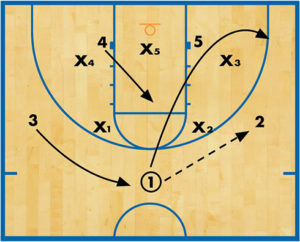10 tips for breaking zone defense
This article looks at offensive concepts against the zone defense. Rather than provide specific plays or actions to run, I want to look at certain concepts that enable you to tailor your offenses to fit your personnel, your style and the variations of defense you might face.
Here are some general guidelines to breaking down the zone defense that should be used in your offense.
1. Transition. You can beat the zone defense in transition if you have an up-tempo team that can push the ball up the floor without giving the defense enough time to get set.
2. Analyze the zone. There are three important questions you should ask yourself:
- Is it an odd or even front? We don’t want to matchup, we want to split the defense to make it have to move to cover the ball. DIAGRAMS 1 and 2 show the typical front alignments your offensive might encounter.
- Are they trapping? This determines whether there is a need to keep a release man close to the ball.
- How are they rotating? This determines the areas of the zone that can be attacked and how it can effectively be screened.
3. Patience. Break down the zone and find the shots that you want. You also must beat the zone from the inside out. Don’t settle for the first open 3-point look you’re given. That shot will be there anytime.
4. Spacing. Do not allow one defender to guard two offensive players. It’s also important that you play behind the defense as much as possible. Wings should be lower than the top of the zone, and the post players should be as low on the baseline as possible.
5. Overload the zone. Design your offenses to move players into areas that give you a numbers advantage on one side of the floor. Put the zone in a situations where at least one defender has no one to guard (DIAGRAM 3).

6. Passing. Passing must be quick and crisp. Do not hold the ball and allow the defense to adjust. Make them late on their rotations.
Reversing the ball is key. Make the zone cover one side of the floor, then the other and then back again. The skip pass can be utilized wing-to-wing or through the post. The ball fake is essential because man defenses react to the man, while zone defense react to the ball. Fake a pass to make a pass.
7. Dribble penetration. Make sure your offense doesn’t over dribble. Either attack the gaps immediately or move the ball.
Dribble penetration is necessary to beat the zone, but it must be done with a purpose. On any dribble penetration, players off the ball should slide behind the defense. Look opposite and inside.

8. Shooting. Have your shooters in a shooting position as often as possible to stretch the zone. Make sure your best shooters are getting their shots, and make sure you are getting shots that your team can make.
9. Inside play. Use the short corner and the high post to your advantage. Attack either low/high, cutting down the lane (DIAGRAM 4) or high/low, cutting inside (DIAGRAM 5).
10. Offensive rebounding. The biggest weakness of any zone is rebounding the ball. Make going to the glass a priority. Second shots mean more layups and free throws.
Breaking down the zone
There are two keys to breaking down any zone defense:
- Alignment/movement. Put the defense in a position where they are forced to cover two options at the same time. This is extremely difficult for the defense to cover and is much easier to do against a zone than it is against a man.
- Misdirection/screening. Since the defense is covering an area instead of an individual, you want to misdirect the defense to one side of the floor, move the ball and screen the recovery.
If the defense is playing man, it decides the matchups and you decide where it plays. If the defense is playing zone, it decides where it’s going to play, and you decide the matchups.
There are two types of offenses that are effective against the zone defense:
- Continuity. This is based on concepts and reads that can be used for extended periods of time against the same defense. You will need two or three, depending on the zone you are facing.
- Quick hits. This can get you a specific shot against the zone. It can usually only be used once or twice, but it can be very effective to break up continuity and also against teams that play zone as a secondary defense.
Chris Hackett has coached at the high school, junior college and university levels, in Kansas, Missouri and Florida. He currently coaches at Frank Phillips College in Texas.









